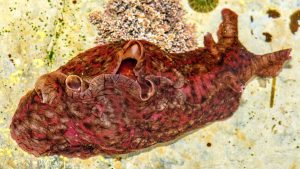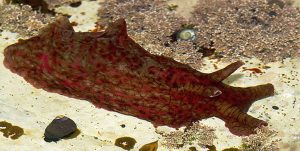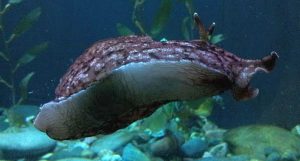The California Sea Hare (Aplysia californica) as the name implies, is found along the coast of California, USA and northwestern Mexico (including the Gulf of California).
The California Sea Hare can usually be found in the intertidal photic zone, at depths of less than a foot, to around 65 feet where they graze on red algae such as Laurencia pacifica, Plocamium pacificum, and Ceramium eatonianum.
Aplysia californica resembles the food that it grazes on and cannot be easily distinguished from the seaweed they are feeding on until they begin to move.
Because of their ability to store toxins from the seaweed that they ingest, they have few predators. The toxic nature of their flesh repels most predators except lobsters, starfish, and the ophistobranch Navanax inermis which consumes juvenile Sea Hares.
The California Sea Hare has a speckled, reddish to greenish brown body, with black splotches. The body color varies depending on what species of algae they ingest. They have two tentacles on the head over the eyes, and two more on the face that surround the mouth. Aplysia californica have an internal shell that protects its internal organs; two parapodia, or folds, that incase and protect the gills, and a footlike muscle that allows them to locomote over the substrate.
When threatened, the California Sea Hare is capable of releasing an ink like substance for protection, much like squid. However, they can release two different types of ink from different locations in their body. A reddish purple colored ink is released from their purple ink gland, and a milky white ink that contains an averse chemical called opaline is released from their opaline gland.
The purple ink creates a dark, diffused cloud in the water that acts as a decoy or screen that disrupts the sensory perception of the predator. The milky opaline ink disrupts the senses associated with feeding. It triggers an instinctive predatory attack on the chemical cloud as if it were food.
The California Sea Hare (Aplysia californica) is a large species that in the wild can grow to over 24 inches in length. In an aquarium environment, they seldom exceed 12 inches in length. The closely related Black Sea Hare (Aplysia vaccaria) can grow even larger than adult Californian sea Hares, which can exceed 30 inches in length and weigh up to 15 pounds.
Because of their large adult size and specialized feeding habits, the California Sea Hare should be housed in a mature FOWLR or reef aquarium of at least 125 gallon capacity with a crushed coral or sandy substrate, some mature live rock, plenty of Laurencia pacifica, Plocamium pacificum, and Ceramium eatonianum to feed on. They are reef safe and will get along with peaceful fish but because of their size may rearrange coral frags and other décor in the tank.
Like all marine invertebrates, the California Sea Hare is sensitive to rapid changes in water quality and need stable water conditions. A good filtration system, protein skimmer, and powerhead
for some moderate water movement will keep them healthy and happy.
Aplysia californica has become a valuable laboratory animal that is being used in plasticity studies and studies of the neurobiology of learning and memory. It has a simple nervous system that is capable of a variety of non associative and associative learning tasks such as habituation, sensation, and operant conditioning.
The California Sea Hare is hermaphroditic. It simultaneously acts as a male and female during mating. Mating usually commences during the summer months when the water temperatures get to 63° F. Egg laying is normally triggered by copulation which almost always occurs during the early morning hours. Although the passage of sperm takes only a few minutes, the act of copulation can last for hours and sometimes even for days. After 8 or 9 days the greenish yellow eggs will turn a brown color, which is a precursor to the eggs hatching out.
It takes about 19 weeks for the California Sea Hare to regenerate itself into a juvenile. The eggs reach the planktonic stage in about 37 days. At around 30 days, the larvae move on from the planktonic stage and begin to feed on red algae. It takes anywhere from 45 to 80 days after the eggs hatch for the larvae to become juveniles. Reproductive maturity is reached 85 days after hatching, which is about 133 days after the fertilized eggs are deposited. on the substrate. Like octopus, the California sea hare often dies shortly after laying their eggs.
In less than a five month period, an individual California Sea Hare weighing 5.8 pounds was recorded to have laid about 500 million eggs during 27 separate spawning occasions.
In their natural habitat, the California Sea Hare feeds mostly in the shallow intertidal zones on several varieties of red algae. Red algae such as Laurencia pacifica, Plocamium pacificum, and Ceramium eatonianum give the Aplysia its pinkish to reddish brown coloration and helps them blend into their surroundings. In an aquarium environment, they require large quantities of algae in their tank to keep them healthy.
Lacking a steady diet of algae in their diet, they will usually not eat enough of anything else to thrive and will slowly starve to death. Because of this and their short life span, only expert tropical fish keeping enthusiasts should attempt to maintain this species.
The California Sea Hare (Aplysia californica) is occasionally available to tropical fish keeping enthusiasts as juveniles from local divers, specialty fish shops, Nudibranch forums, and a few online sources who sell Nudibranchs at reasonable prices.
Minimum Tank Size: 125 gallons
Aquarium Type: Established FOWLR or Reef
Care Level: Moderate
Temperament: Peaceful
Aquarium Hardiness: Relatively hardy
Water Conditions: 72-78°F, dKH 8 to 12, pH 8.1-8.4, sg 1.023-1.025
Max. Size: 16″
Color Form: Reddish Brown, Black, Purple
Diet: Herbivore
Compatibility: Reef Compatible
Origin: eastern Pacific Ocean
Family: Aglajidae
Lifespan: Unkonwn
Aquarist Experience Level: Advanced




